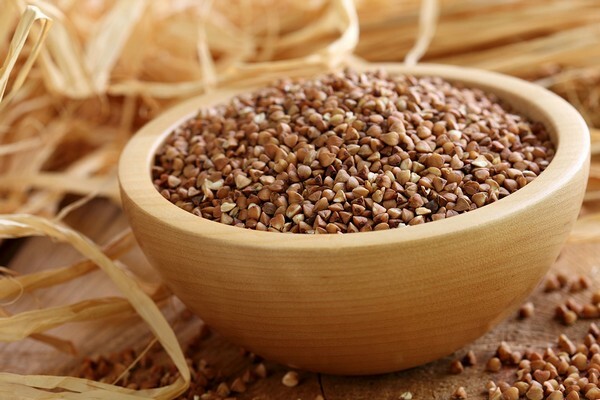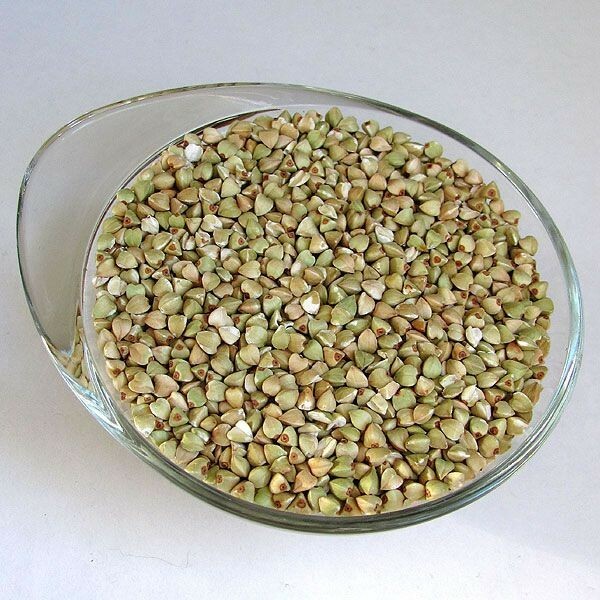Buckwheat is considered one of the most useful among other cereals due to the high content of vitamins and minerals. From it you can prepare a variety of delicious dishes for breakfast, lunch or dinner, which are equally popular with adults and children alike. These include buckwheat porridge with milk, meat sauce, mushrooms or vegetables, casseroles, soups, pancakes made from buckwheat flour, pancakes, Greek, burgers, etc. What are the minerals and vitamins in buckwheat contained, and why is it so useful? Buckwheat is a valuable dietary product, because it contains a lot of fiber and refers to slow carbohydrates, so after using it, the person remains full for a long time. In cooking, several types of buckwheat are used: the core( whole grain), the chopped( split in half or finer grain), buckwheat flour and green buckwheat( uncooked, uncooked grain).

Buckwheat composition
The energy value of buckwheat in dry form is 340 kcal per 100 g of product. At the same amount of cereals account for 68 grams of carbohydrates, including 10 grams of coarse plant fiber in the form of fiber, 13 g of protein and 3 g of fat. The glycemic index of the product is in the range of 50-60 depending on the type of cereal and the way it is prepared.Vitamins
The content of vitamins in buckwheat is within the limits typical for cereals. However, buckwheat is especially rich in B vitamins, which, when used together as part of this product, enhance each other's action. By the amount of vitamin B1, it is ahead of many other food products used in food. Find out what vitamins in buckwheat are contained and their amounts can be found in the following table:
| Vitamins | Amount of mg per 100 g of dry product | % of daily norm |
| B1 | 0.43 | 28 |
| B2 | 0.20 | 11 |
| B3( or PP) | 4.20 | 21 |
| B6 | 0.40 | 20 |
| B9 | 0.032 | 8 |
| E | 6.7 | 44 |
| A | 0.006 | 0.6 |
Vitamins present in buckwheat have important biological properties for the body. Vitamin A reduces the risk of eye diseases, strengthens bones and regenerates tissues, has an antioxidant effect and a positive effect on hair and skin. Tocopherol( vitamin E) also exhibits antioxidant activity, protects body cells from the action of free radicals, increases immunity, participates in the synthesis of collagen and elastin, improves the nutrition of tissues, increasing the supply of oxygen and nutrients to them.
Interesting: Buckwheat is an environmentally friendly product, as it is absolutely unpretentious to soils and its growth is not hampered by weeds. This allows you to grow it without using insecticides, pesticides and fertilizers.
Group B vitamins play an important role in the normal functioning of the body. They support the functions of the central nervous system, protect against the negative effects of stress, regulate many metabolic processes:
- Vitamin B1 is involved in the processes of nervous excitation, metabolic processes, activates brain activity, improves memory;
- Vitamin B2 takes part in oxidation-reduction( redox) reactions in the body, synthesis of essential fatty acids, protein metabolism, has a beneficial effect on the reproductive system, is necessary for the synthesis of red blood cells, neurotransmitters, histamine and other important compounds for the body;
- Vitamin B6 strengthens immunity, participates in the synthesis of vitamin PP, normalizes the work of the nervous system, water-salt balance, eliminates muscle cramps, participates in the synthesis of red blood cells, many enzymes, assists in the assimilation of fatty acids, improves memory and metabolic processes in the brain tissues,;
- Vitamin B9 affects the processes of cell division and tissue growth, supports the work of the nervous, immune and cardiovascular systems, reduces the risk of developing cancer;
- Vitamin B3 has a vasodilating effect, enhances blood circulation, participates in tissue respiration processes, redox reactions, protein and carbohydrate metabolism, promotes the synthesis of useful cholesterol and fatty acids, normalizes the CNS, reduces the risk of heart and vascular disease.

How many vitamins are in buckwheat? In the usual( brown) cereal contains 7 vitamins, but green buckwheat, that is, raw, not past the preliminary frying, contains additionally vitamin P or rutin. It is a flavonoid glycoside that breaks down under the influence of high temperatures. Rutin strengthens the vascular walls, controls the production of articular fluid, necessary for the normal operation of the joints. Vitamin P also increases the activity of vitamin C, reduces the risk of internal bleeding and hemorrhage, prevents the development of atherosclerosis, increases immunity, and has a positive effect on the endocrine system.
Mineral substances
There are quite a lot of phosphorus, potassium and magnesium, sulfur, silicon, iron and manganese from minerals in buckwheat. In 100 g of dry cereals the following percentages of some minerals are from the daily norm:
- manganese - 80%;
- magnesium - 55%;
- phosphorus - 32%;
- copper - 31%;
- zinc - 16%;
- iron - 14%;
- selenium - 12%;
- potassium - 9%;Calcium
- - 2%.
The quantitative content of macro- and microelements in buckwheat is reflected in the table:
| Microelements | Quantity per 100 g of dry product | Macronutrients | Quantity mg per 100 g dry product |
| Silicon | 81 mg | Phosphorus | 334 |
| Iron | 6.7 mg | Potassium | 380 |
| Zinc | 2.0 mg | Magnesium | 230 |
| Manganese | 2 mg | Chloro | 33 |
| Titanium | 33 g Sulfur |
| 80 |
| Nickel |
| 10 mcg Selenium Calcium | 18 |
|
| 8 g Sodium |
| 3 |
|
| Chromium 4 mcg | ||
|
| Copper 640 mcg Cobalt | ||
|
| 3 ug | ||
| Fluoro |
| ||
| 23 mcg Molybdenum 34 mcg |
|
Useful properties GkEve cereals
Buckwheat is an ideal dietary product, which in one form or another is permitted to use almost all diseases. It is recommended for atherosclerosis and hypertension, weak immunity, joint diseases, gastritis and peptic ulcer, constipation, liver disease, depressive conditions, obesity.
Buckwheat has a balanced composition of proteins, fats and carbohydrates. It is very useful for people who are trying to reduce their weight, since it helps to accelerate metabolism and after its use, a person for a long time retains a sense of satiety. It is especially valuable for vegetarians, since the plant protein that it contains contains irreplaceable amino acids and is equal in value to meat. According to the amino acid composition, buckwheat is comparable with leguminous crops( beans, beans, peas).Buckwheat refers to complex carbohydrates and slowly increases the level of glucose in the blood, so it is included in the menu of people with diabetes.

A large amount of fiber in buckwheat helps to normalize the functions of the gastrointestinal tract, improves intestinal peristalsis. In addition, it helps to remove toxins from the body and harmful cholesterol.
As part of buckwheat flavonoids - plant polyphenols, which have the property of diluting blood, improve its rheological properties and dissolve thrombi, reduce the permeability and fragility of small vessels, reduce the risk of cancer.
Green buckwheat due to maintenance routine is very useful for hemorrhoids and varicose, as well as for the prevention of various vascular diseases, reducing the risk of heart attack, stroke.
Interestingly: Unlike other grains, buckwheat is a seed of the buckwheat flower, not a cereal crop. It does not contain gluten, which in some adults and children causes allergies and a significantly narrowing list of products that they are allowed to consume.
